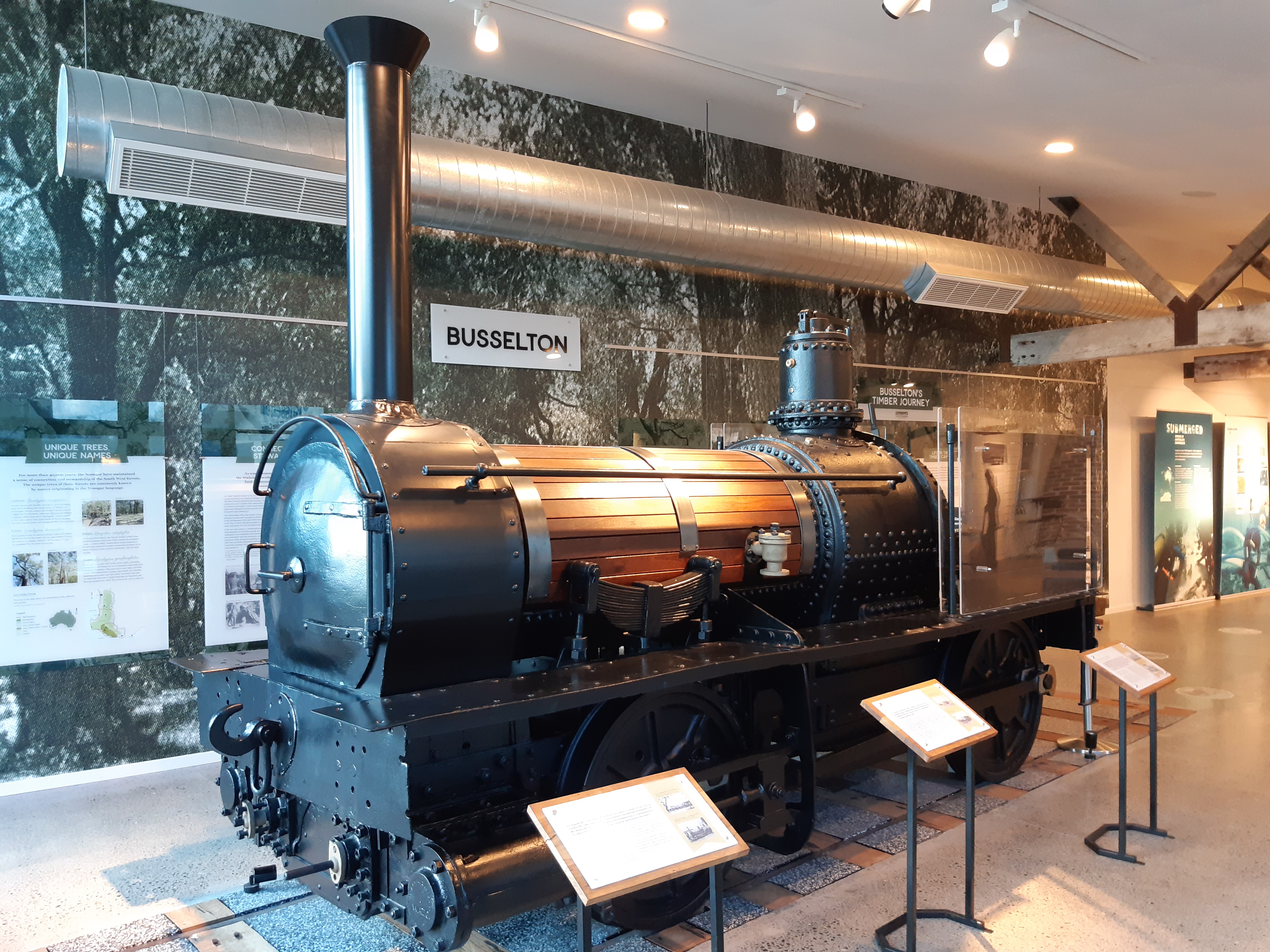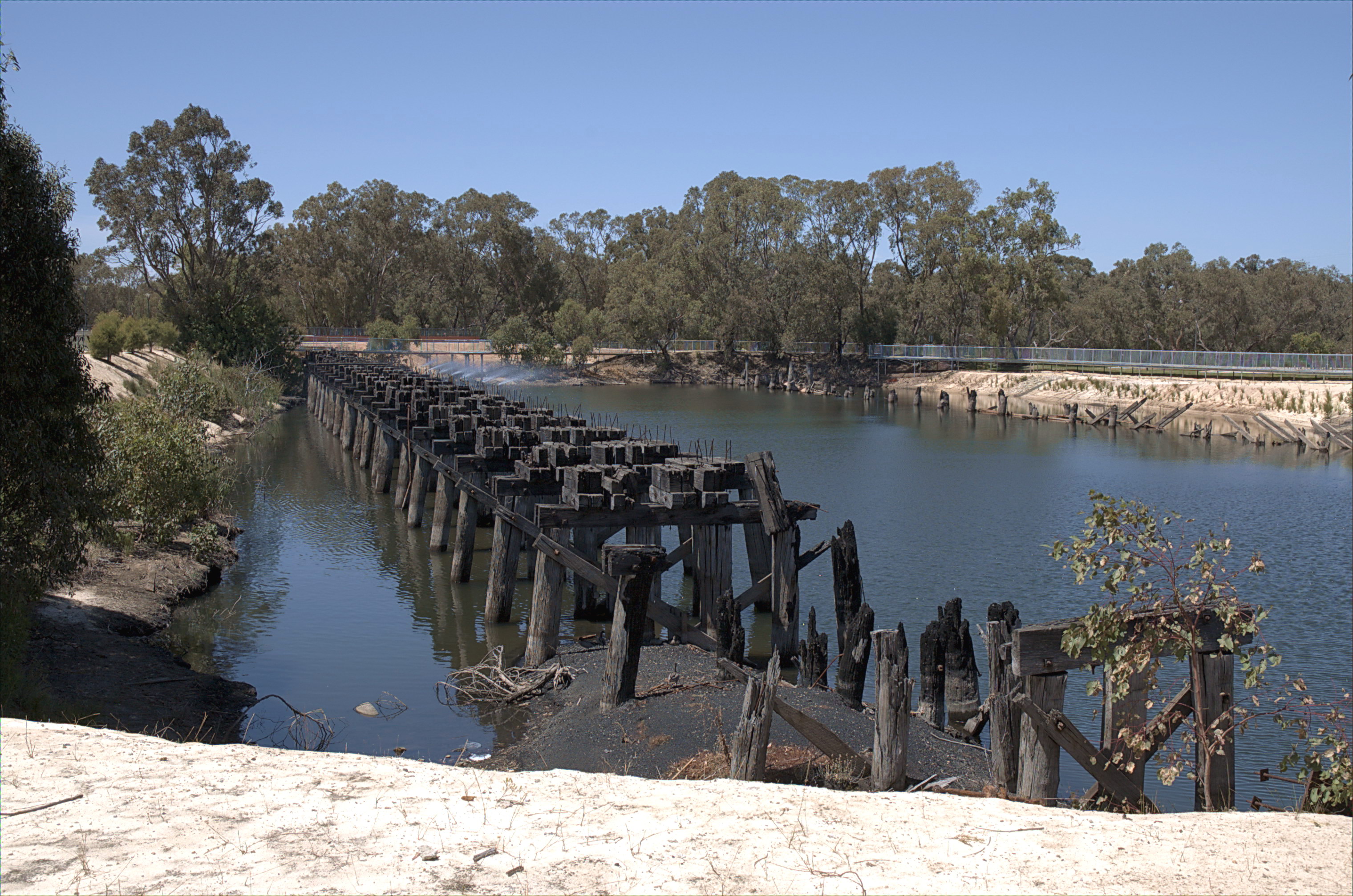|
Ballaarat Steam Engine
The Ballaarat steam engine, built by James Hunt's Victoria Foundry in the city of Ballarat, Victoria in 1871, was the first gauge locomotive built in Australia. It was purchased by the Western Australian Timber Company, which was awarded one of only three milling concessions granted in the colony. The company had 181,500 acres to mill at Yoganup, near the town of Busselton. History Active use The Western Australian Timber Company shipped the locomotive from Victoria to transport timber to the coast over the Ballaarat Tramline from its mill – first located at Yoganup, inland, and later as far as inland. The company had built the colony's first timber-railed railway line (on which timber rails were topped by an iron strap to reduce wear) from the mill to a landing jetty at Lockville, near Wonnerup, north-east of Busselton. Timber milling was the region's biggest industry and timber was the biggest export industry in Western Australia until World War 1. The narr ... [...More Info...] [...Related Items...] OR: [Wikipedia] [Google] [Baidu] |
Ballaarat Steam Engine, August 2020 01
Ballarat ( ) is a city in the Central Highlands of Victoria, Australia. At the 2021 Census, Ballarat had a population of 116,201, making it the third largest city in Victoria. Estimated resident population, 30 June 2018. Within months of Victoria separating from the colony of New South Wales in 1851, gold was discovered near Ballarat, sparking the Victorian gold rush. Ballarat subsequently became a thriving boomtown that for a time rivalled Melbourne, the capital of Victoria, in terms of wealth and cultural influence. In 1854, following a period of civil disobedience in Ballarat over gold licenses, local miners launched an armed uprising against government forces. Known as the Eureka Rebellion, it led to the introduction of male suffrage in Australia, and as such is interpreted as the origin of Australian democracy. The rebellion's symbol, the Eureka Flag, has become a national symbol. It was on display at Ballarat's Museum of Australian Democracy at Eureka (MADE) from 2013 ... [...More Info...] [...Related Items...] OR: [Wikipedia] [Google] [Baidu] |
Midland Railway Workshops
The Midland Railway Workshops in Midland, Western Australia, were the main workshops for the Western Australian Government Railways (WAGR) for over 80 years. History The first railway workshops in Western Australia were located at Fremantle and shifted to Midland in 1904. The Midland Railway Workshops were involved with all WAGR rolling stock and engine construction and maintenance. Steam engines continued to operate on mainline service until 1971, and all major maintenance occurred at the workshops. Workforce Generations of workers at the workshops had considerable numbers of European migrants who arrived in Australia with limited English language, and there were significant groups of Italian migrants in the workforce. The workforce of the workshops had a rich history and, since closing, there have been projects to record oral history and collect information about the place and people involved. Closure In April 1993, the Richard Court Liberal State Government announced tha ... [...More Info...] [...Related Items...] OR: [Wikipedia] [Google] [Baidu] |
Steam Locomotives Of Western Australia
Steam is a substance containing water in the gas phase, and sometimes also an aerosol of liquid water droplets, or air. This may occur due to evaporation or due to boiling, where heat is applied until water reaches the enthalpy of vaporization. Steam that is saturated or superheated is invisible; however, "steam" often refers to wet steam, the visible mist or aerosol of water droplets formed as water vapor condenses. Water increases in volume by 1,700 times at standard temperature and pressure; this change in volume can be converted into mechanical work by steam engines such as reciprocating piston type engines and steam turbines, which are a sub-group of steam engines. Piston type steam engines played a central role in the Industrial Revolution and modern steam turbines are used to generate more than 80% of the world's electricity. If liquid water comes in contact with a very hot surface or depressurizes quickly below its vapor pressure, it can create a steam explosion. Types ... [...More Info...] [...Related Items...] OR: [Wikipedia] [Google] [Baidu] |
Railway Locomotives Introduced In 1871
Rail transport (also known as train transport) is a means of transport that transfers passengers and goods on wheeled vehicles running on rails, which are incorporated in tracks. In contrast to road transport, where the vehicles run on a prepared flat surface, rail vehicles (rolling stock) are directionally guided by the tracks on which they run. Tracks usually consist of steel rails, installed on sleepers (ties) set in ballast, on which the rolling stock, usually fitted with metal wheels, moves. Other variations are also possible, such as "slab track", in which the rails are fastened to a concrete foundation resting on a prepared subsurface. Rolling stock in a rail transport system generally encounters lower frictional resistance than rubber-tyred road vehicles, so passenger and freight cars (carriages and wagons) can be coupled into longer trains. The operation is carried out by a railway company, providing transport between train stations or freight customer faciliti ... [...More Info...] [...Related Items...] OR: [Wikipedia] [Google] [Baidu] |
Individual Locomotives Of Australia
An individual is that which exists as a distinct entity. Individuality (or self-hood) is the state or quality of being an individual; particularly (in the case of humans) of being a person unique from other people and possessing one's own needs or goals, rights and responsibilities. The concept of an individual features in diverse fields, including biology, law, and philosophy. Etymology From the 15th century and earlier (and also today within the fields of statistics and metaphysics) ''individual'' meant " indivisible", typically describing any numerically singular thing, but sometimes meaning "a person". From the 17th century on, ''individual'' has indicated separateness, as in individualism. Law Although individuality and individualism are commonly considered to mature with age/time and experience/wealth, a sane adult human being is usually considered by the state as an "individual person" in law, even if the person denies individual culpability ("I followed instruct ... [...More Info...] [...Related Items...] OR: [Wikipedia] [Google] [Baidu] |
WAGR G Class G233 Leschenault Lady
WAGR G class G233 ''Leschenault Lady'' is a preserved steam locomotive, built in 1898 by James Martin & Co of Gawler, South Australia, for the Western Australian Government Railways (WAGR). It is the third oldest Australian-built steam locomotive still in operational order, after Victorian Railways Y class 112 and WAGR A class 15. Background Between 1889 and 1899, a total of 48 G class engines were acquired by the WAGR, both new and second-hand. They were designed by Beyer, Peacock & Co of Manchester, England, but most of them were built by James Martin & Co at Gawler, a short distance north of Adelaide, South Australia. The G class engines were the first locomotive class to be introduced to the WAGR network in quantity, and were part of what became almost an Australian standard. Initially, the WAGR used them as main line general purpose locomotives, on passenger, mixed and goods trains. Service history G233 was one of the G class locomotives built by James Martin & Co. ... [...More Info...] [...Related Items...] OR: [Wikipedia] [Google] [Baidu] |
Model Engineering
Model engineering is the pursuit of constructing proportionally-scaled miniature working representations of full-sized machines. It is a branch of metalworking with a strong emphasis on artisanry, as opposed to mass production. While now mainly a hobby, in the past it also had commercial and industrial purpose. The term 'model engineering' was in use by 1888. In the United States, the term 'home shop machinist' is often used instead, although arguably the scope of this term is broader. Model engineering is most popular in the industrialised countries that have an engineering heritage extending back to the days of steam power. That is, it is a pursuit principally found in the UK, USA, northwestern European countries and the industrialised British Commonwealth countries. Scope of model engineering The 'classic' areas of model engineering interest are live steam models (typically steam locomotives, stationary engines and traction engines), internal combustion engines, and clock maki ... [...More Info...] [...Related Items...] OR: [Wikipedia] [Google] [Baidu] |
Live Steam
Live steam is steam under pressure, obtained by heating water in a boiler. The steam is used to operate stationary or moving equipment. A live steam machine or device is one powered by steam, but the term is usually reserved for those that are replicas, scale models, toys, or otherwise used for heritage, museum, entertainment, or recreational purposes, to distinguish them from similar devices powered by electricity, internal combustion, or some other more convenient method but designed to look as if they are steam-powered. Revenue-earning steam-powered machines such as mainline and narrow gauge steam locomotives, full-sized steamships, and the worldwide electric power-generating industry steam turbines are not normally referred to as "live steam". Steamrollers and traction engines are popular, in 1:4 or 1:3 scale, as are model stationary steam engines, ranging from pocket-size to 1:2 scale. Railroads or railways Ridable, large-scale live steam railroading on a backyard ... [...More Info...] [...Related Items...] OR: [Wikipedia] [Google] [Baidu] |
Model Engineer
''Model Engineer Magazine'' was first published (in the United Kingdom) to support the hobby of model engineering in 1898 by Percival Marshall, who was to remain its editor for over 50 years. It has been owned by MyTime Media since 2008. The magazine addressed the emergence of a new hobby — the construction of models (often working) and experimental engineering, largely in metal. It transcended class barriers, appealing to professional engineers, jobbing machinists and anyone interested in making working mechanisms. Contributors The magazine has had many notable contributors, but foremost among these was LBSC ( pen name of Lillian 'Curly' Lawrence). From the inter-war period to the 1960s he produced many designs for simple but reliable small model steam locomotives. Most of these were published in ''Model Engineer'', and brought the construction of small passenger hauling locomotives within the reach of the typical home machinist. Other notable contributors include Henry Green ... [...More Info...] [...Related Items...] OR: [Wikipedia] [Google] [Baidu] |
City Of Busselton
The City of Busselton is a local government area in the South West region of Western Australia, approximately south of Perth, the state capital. The city covers an area of and had a population of 40,640 as at the 2021 Census. It contains two large towns, Busselton and Dunsborough, and a number of smaller towns. The city office is located on Southern Drive, Busselton. History The City of Busselton was established as the Busselton Road District on 11 May 1951 with the amalgamation of the Municipality of Busselton, governing the area of Busselton bounded by West Street and Ford Road, and the Sussex Road District, governing the remaining area. Both bodies had been established in 1871. The road district was declared a shire and became the Shire of Busselton with effect from 1 July 1961 following the passage of the ''Local Government Act 1960'', which reformed all remaining road districts into shires. In 2007 it abolished its system of wards for electing councillors. On 21 Jan ... [...More Info...] [...Related Items...] OR: [Wikipedia] [Google] [Baidu] |






